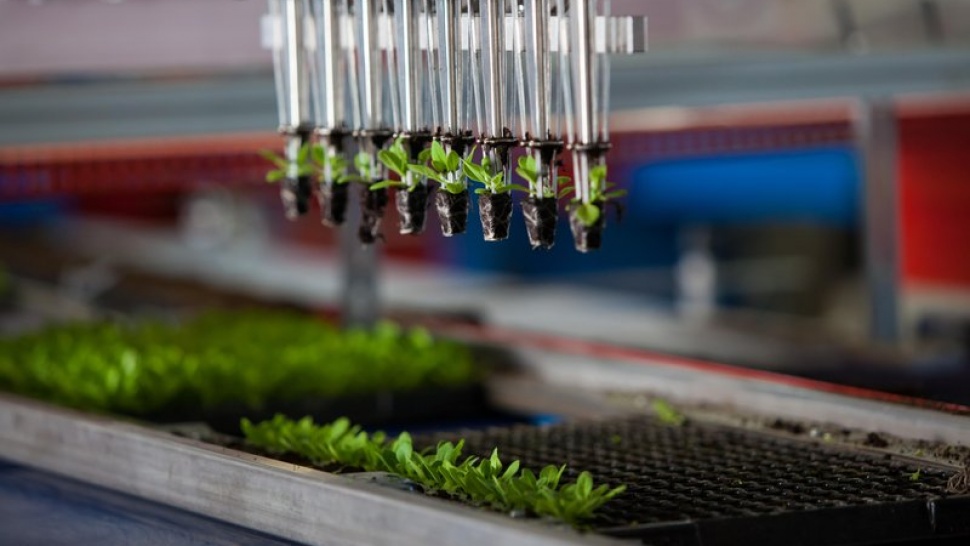1. Self-driving tractors
Don’t be fooled by new self-driving cars – farmers have been doing it for years. Admittedly, up until this point, they have required a human in the cab to ensure the survival of any rogue livestock. However, in August 2016 Case IH revealed its ‘autonomous concept vehicle’ developed in partnership with autonomous solutions company ASI. These autonomous tractors are remotely programmed by tablet to till, crop, fertilise or plant to a farmer’s exact specifications using the same kind of obstacle detection, radar and cameras you’d find in any other driverless set-up. And, because they don’t need sleep or lunch breaks, they can work all day and all night.
But the big boys of ag aren’t the only ones pursuing driverless tech. Members of Harper Adams University’s engineering staff are looking to beat them to the punch by growing and harvesting a full field of cereal crops without getting a single speck of mud on their boots as part of their ‘Hands Free Hectare’ project. They’ll be adapting small-scale machinery that’s already on the market and researcher Kit Franklin says: “It’s not about putting people out of jobs, but instead changing the job they do”. So, rather than getting physical in the fields, farmers will soon become fleet managers or, as we think it’s fun to think of them, robot overlords...
2. Fruit-picking agbots
Apple picking, or fruit picking in general for that matter, has always been a pretty manual process. Now all manner of robotic technologies are emerging to get that fruit off the tree and into your five a day. Many of the ideas are coming from ag start-ups, including the US-based Abundant Robotics Inc whose apple-harvesting robots are designed to pick one apple per second without damaging the fruit or trees thanks to computer vision detection and a vacuum-type removal system. According to Abundant Robotics’ CEO and co-founder Dan Steere, you can expect to see these autonomous apple-picking robots hard at work in orchards within the next two years, and it’s likely packing robots are already on the job in a shed near you.
3. Smart sensors
As a so-called ‘superfood’, almonds have experienced a surge in popularity. But while they’ve been enjoying their time in the sun, statistics have emerged around their huge demand on freshwater. In fact, experts believe a single almond takes 3.8 litres of water to grow. That’s where new ‘smart’ sensor technology comes in.
Planted throughout nut groves, moisture sensors can now keep track of what’s going on in the soil, data is then automatically uploaded to the cloud where it is analysed and sent back to irrigation systems to ensure not a drop is wasted. But it’s not just nuts: farmers in New Zealand are even keeping track of cow urine with technology like Agrioptics’ SmartN that detects where cows have ‘been’ and uses this information to make sure those spots don’t get any more fertiliser – they’ve had enough already.
4. Swarms of drones
Drones. They’re everywhere. And it seems they’re being used for almost everything, including spraying, monitoring, land mapping and pest detection in agriculture. In the future, they may even start working in swarms, attracting one another to weed-infested areas allowing for more heavily concentrated inspection and treatment. What’s more, a global report by PwC puts the market value of agricultural drone technology at around $32.4 million USD. Got a good drone idea up your sleeve? Now’s the time to act.

5. The great indoor
Who said farming was an outdoor activity? With limited land and increasing urbanisation, researchers in Hong Kong have developed a smart indoor solution that accelerates plant growth using a computerised system to optimise the growing environment dependent on the species. The system can reduce water consumption by 95 percent and it’s designed to be set up in urban environments to help city dwellers maintain a sustainable food supply.
But as well as ‘in’, many growers are thinking ‘up’, including Canadian-based Arcturus Growthstar Technologies who specialise in LED lights that allow plants to be grown on vertically stacked levels.




Share the News